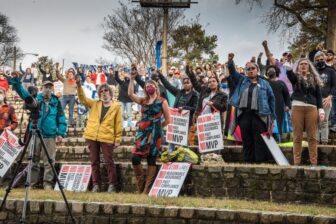On the morning of Tuesday, November 1st, around 35 supporters showed up to Baltimore City Hall adorned in red shirts to attend the city’s Judiciary Committee hearing. The coalition, made up of citizens, community association representatives, and health and environmental organizations, was there to support Ordinance 16-0621, also known as the oil train ordinance. The bill called upon the city to conduct the first-ever health impact and risk assessment of the dangers that explosive oil trains pose as they roll through Baltimore.
 In recent years the oil industry has increasingly used rail as a means to transport crude oil, and Baltimore has become a throughway for this highly explosive cargo, much of it from fracking operations in the Bakken shale fields of North Dakota. From 2013 to 2014, over 100 million gallons of crude oil were transported into Baltimore by rail to be offloaded and shipped to refineries. Much more crude oil likely travels through Baltimore. Maps show that oil train routes put 165,000 people in the “blast zone” in Baltimore – the area that could be directly impacted if a train were to derail and explode. Bakken crude oil is highly volatile and a number of high profile derailments — such as the 2013 derailment in Lac-Mégantic, Quebec that led to an explosion killing 47 people and leveling over 30 buildings — have caused communities around the North America to take action.
In recent years the oil industry has increasingly used rail as a means to transport crude oil, and Baltimore has become a throughway for this highly explosive cargo, much of it from fracking operations in the Bakken shale fields of North Dakota. From 2013 to 2014, over 100 million gallons of crude oil were transported into Baltimore by rail to be offloaded and shipped to refineries. Much more crude oil likely travels through Baltimore. Maps show that oil train routes put 165,000 people in the “blast zone” in Baltimore – the area that could be directly impacted if a train were to derail and explode. Bakken crude oil is highly volatile and a number of high profile derailments — such as the 2013 derailment in Lac-Mégantic, Quebec that led to an explosion killing 47 people and leveling over 30 buildings — have caused communities around the North America to take action.
Normally, committee hearings in Baltimore are rather banal events – just another administrative hurdle in the life of aspiring city legislation. With the oil trains ordinance, however, things have not been so simple.
The ordinance was introduced by City Council President Jack Young in January 2016 with near-unanimous support amongst members of the Council. The bill represented a first step toward giving communities and emergency responders vital information about the severity of the risks to public health and safety. After being introduced, however, the legislation languished in legislative purgatory, with neither President Young nor Councilman Jim Kraft, the chair of the Judiciary Committee, scheduling a hearing. After months of reaching out to elected officials and hearing nothing in response, a group of concerned Baltimore citizens organized a silent protest at the September 13th Judiciary Committee hearing to urge elected officials to break the collective silence on Baltimore oil trains. It was at this hearing that Councilman Kraft announced that he had just scheduled a hearing for the oil trains ordinance on November 1st.
On the morning of November 1st the council chambers were packed. By the time the committee took up the oil trains ordinance, the hearing had already gone two and a half hours over schedule. After reconvening from a recess, Councilman Kraft issued a deadly blow to the ordinance: citing negative reports published by the city’s finance and law departments, he said that the committee would no longer be voting on the ordinance, although they would still open the hearing up to public comments. These negative reports seemingly came out of nowhere – especially the law department’s report, with whom CCAN had worked previously to vet the legality of the ordinance. By tabling the bill, the committee essentially killed the legislation for 2016, despite its broad support.
 Even in the face of these devastating last-minute changes, supporters held their ground. Nearly 20 community members, coalition partners, and organizations provided testimony on the need to do something about explosive “bomb” trains in the city.
Even in the face of these devastating last-minute changes, supporters held their ground. Nearly 20 community members, coalition partners, and organizations provided testimony on the need to do something about explosive “bomb” trains in the city.
“These trains run in close proximity to over 40 schools in Baltimore city,” said community member Ulysses Archie. “We need to know the threat that oil trains pose to our communities so we can be properly prepared.”
Councilwoman Mary Pat Clarke stood resolute at the hearing, promising to take the lead on crafting a stronger ordinance at the start of the new legislative session in 2017. Additionally, January will mark the swearing in of a brand new City Council, filled with promising new council members that are eager to make a reputation for themselves as results-oriented progressives in the community.
While the death of Ordinance 16-0621 comes as a setback to those seeking environmental justice in Baltimore, it by no means signals the end of the campaign. With a strong legislative advocate and new City Council, 2017 looks to be a promising year for Baltimore City Government to take desperately needed action to put the brakes on dangerous crude oil trains.
To read more about the oil trains campaign in Baltimore read Part I and Part II of a recent Baltimore Brew series, and watch CBS coverage of the November 1st hearing.





